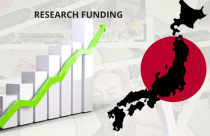Can Innovation Change the Future of Science in Japan?

Earlier this year, we wrote about science in Japan. In that piece, we said that Japan conducts less research because the country does not have much research funding. Why? The economy in Japan is not good. According to The Balance, Japan’s economy has been doing poorly for 20 years. In addition, recent natural disasters, like the 2011 earthquake caused more economic problems costing almost $360 billion!
An Update on Japanese Science Funding
Because of the weak economy, Japanese researchers don’t get much funding. International research collaboration is important. Without funding, Japan cannot attract researchers from other countries in the world. In Asia, China and South Korea attract more researchers. Even at top research institutions, like RIKEN, some scientists have had budget cuts of nearly 50% this year!
Now, Japan is trying to change things. Innovation in science is just as important as collaboration. Instead of attracting researchers with broad funding, Japan’s approach is to innovate. Some new developments are causing controversy. In this article, we report on the news about Japanese research innovations.
The PRISM Program and Japan’s Growth Strategy
Recently, there have been some reports of a new growth strategy in Japan. According to a piece in Nature Index, the Japanese government has new plans. The government will spend more on science and technology. They will increase funds for science by 900 billion Yen (that’s $8.3 billion) in three years! Japanese Prime Minister Shinzo Abe proposed this change as part of a broad growth plan.
How will Japan spend the extra money? Much of the funds will go to the PRISM program. The PRISM program funds partnerships between firms and academia. This could increase demand for academic research and yield incentives for researchers to publish and collaborate. However, only existing projects are eligible. The PRISM program encourages good ideas to accomplish existing goals.
There are some critics of the PRISM program. These projects can only be in certain fields. One university president claimed that PRISM would limit funding for basic research. Researchers only in a selected few fields will benefit from more PRISM funds. For example, Japan does not prioritize medical research. Only innovative fields, like AI and robotics can get more funding.
Innovation, Patents, and “Useful” Science
Japan’s focus on innovation is not a surprise. The government wants their science funds to be useful. For this science should lead to innovation—at least, according to the common view. Innovation is sometimes measured using inventions, or patents. Data from Lens.org show that publications and patents are linked. Institutions with more work published tend to have more patents. Also, work in highly cited journals is linked with more patents. See the infographics here.
Though this information is interesting, it is not perfect. There are other perspectives. For example, some of the most useful science is in medicine. Medical advances might or might not be associated with patents. New ideas about nutrition, for example, might not need patents to be useful. Instead, people change their behavior and become healthier. Therefore, patents and innovation are not always linked with high-quality science.
What does this mean for Japan? As some critics point out, this means that science may become one-sided. Japan strives to create “Society 5.0”, which is the idea of a smart society. Society 5.0 “seamlessly integrates cyberspace with the real world.” This is an interesting goal. However, technology is not enough to make a culture competitive.
Looking to the Future of Japanese Research
The PRISM program and Japan’s growth plans aren’t perfect. However, they are a step in the right direction. In order to compete, Japan must improve its economy. New tech innovations will help and with more funds going to scientists in some fields, growth will follow. If Japan can create Society 5.0, Japanese firms will bring money into the country. They will export technologies and products that improve society. More tech imports will bring more money to the Japanese government. With this money, Japan can fund other types of science.
Researchers in non-tech fields may be upset today, however, they should look on the bright side. In 5-10 years, the budget cuts may stop and instead, budget increases may be available. This is possible if Japan can be a tech leader in the future. The government is taking a long-term view of Japanese science. Researchers in all fields should be glad that Abe is paying attention to science.
What do you think of Japan’s plan? Will it lead to increased scientific research output? Will medical scientists and others lose out? Can Japan turn around its 20-year recession? Have you experienced budget cuts? Tell us in the comments what you think!









